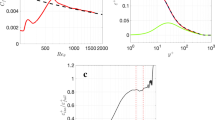Abstract
The present study reports measurements of a turbulent boundary layer in an open-channel flow using fiber-optic laser Doppler anemometry. The Reynolds numbers based on momentum thickness and depth of flow are in the range 750≤Re θ ≤2,400 and 15,300≤Re h ≤54,200, respectively. It is shown that an accurate estimate of the wall shear stress can be made by fitting a fifth-order polynomial to the near-wall data. The effect of Reynolds number on the mean turbulence intensity and triple correlation is examined using both conventional scaling laws and the recent scaling laws proposed by George and Castillo. The present results show that different scaling laws lead to different conclusions on low Reynolds number effects.







Similar content being viewed by others
References
Antonia RA, Bisset DK, Browne LWB (1990) Effect of Reynolds number on the topology of the organized motion in a turbulent boundary layer. J Fluid Mech 213:267–286
Balachandar R, Blakely D, Tachie MF, Putz G (2001) A study of turbulent boundary layer on a smooth flat plate in an open channel. J Fluids Eng 123:394–400
Balachandar R, Ramachandran S (1999) Turbulent boundary layers in low Reynolds number shallow open channel flows. J Fluids Eng 121:684–689
Barenblatt GI, Prostokishin VM (1993) Scaling laws for fully developed turbulent shear flows. 1. Processing of experimental data. J Fluid Mech 248:521–529
Bergstrom DJ, Tachie MF, Balachandar R (2001) Application of power laws to low Reynolds number boundary layers on smooth and rough surfaces. Phys Fluids 13:3277–3284
Ching CY, Djenidi L, Antonia RA (1995) Low-Reynolds-number effects in a turbulent boundary layer. Exp Fluids 19:61–68
Durst F, Fischer M, Jovanovic J, Kikura H (1998) Methods to set up and investigate low Reynolds number, fully developed turbulent plane channel flows. J Fluids Eng 120:496–503
Durst F, Kikura H, Lekakis I, Jovanovic J, Ye Q (1996) Wall shear stress determination from near-wall mean velocity data in turbulent pipe and channel flows. Exp Fluids 20:417–428
Eriksson JG, Karlsson RI, Persson J (1998) An experimental study of a two-dimensional plane wall jet. Exp Fluids 25:50–60
Gad-el-Hak M, Bandyopadhyay PR (1994) Reynolds number effects in wall-bounded turbulent flows. Appl Mech Rev 47:307–365
George WK, Castillo L (1997) Zero pressure gradient turbulent boundary layer. Appl Mech Rev 50:689–729
Harder KJ, Tiederman WG (1991) Drag reduction and turbulent structure in two-dimensional channel flows. Phil Trans R Soc London A 336:19–34
Johansson AV, Alfredson PH (1983) Effects of imperfect spatial resolution on measurements of wall-bounded turbulent shear flow. J Fluid Mech 137:411–423
Johansson AV, Alfredson PH (1986) Structure of turbulent channel flows. In: NP Cheremisinoff (ed) Encyclopedia Fluids Mech 1:825–869
Johansson G, Castillo L (2001) LDA measurements in turbulent boundary layers with zero pressure gradient. In: E Lindborg, A Johansson, J Eaton, et al. (eds) Turbulence and shear flow phenomena, second international symp, vol 2, KTH, Stockholm, 27–29 June, pp 15–20
Karlsson RI, Eriksson JG, Persson J (1992) LDV measurements in a plane wall jet in a large enclosure. In: Proc 6th international symposium appl laser tech fluid mech, 20–23 July, Lisbon, Portugal, paper 1:5
Kim J, Moin P, Moser R (1987) Turbulence statistics in fully developed channel flow at low Reynolds number. J Fluid Mech 177:133–166
Komori S, Nagaosa R, Murakami Y, Chiba S, Ishii K, Kuwahara K (1993) Direct numerical simulation of three-dimensional open channel flow with zero-shear gas-liquid interface. Phys Fluids 5:115–125
Krogstad PA, Antonia RA, Browne LWB (1992) Comparison between rough- and smooth-wall turbulent boundary layers. J Fluid Mech 245:599–617
Krogstad PA, Antonia RA (1999) Surface roughness effects in turbulent boundary layers. Exp Fluids 27:450–460
Milikan CB (1938) A critical discussion of turbulent flows in channels and circular tubes. In: Proc 5th international cong appl mech, Cambridge, p 386
Nezu I, Rodi W (1986) Open-channel flow measurements with a laser Doppler anemometer. J Hydr Eng 112:335–355
Osaka H, Kameda T, Mochizuki S (1997) Re-examination of the Reynolds-number-effect on the mean flow quantities in a smooth wall turbulent boundary layer. JSME Int J Series B 41:123–129
Purtell LP, Klebanoff PS, Buckley FT (1981) Turbulent boundary layer at low Reynolds number. Phys Fluids 24:802–811
Simpson RL, Chew YT, Shivaprased BG (1981) The structure of a separating turbulent boundary layer. 2. Higher-order turbulence results. J Fluid Mech 113:53–73
Spalart PR (1988) Direct simulation of a turbulent boundary layer up to Re θ =1410. J Fluid Mech 187:61–98
Tachie MF, Bergstrom DJ, Balachandar R (2000) Rough wall turbulent boundary layers in shallow open channel flow. J Fluids Eng 122:533–541
Wei T, Willmarth WW (1989) Reynolds-number effects on the structure of a turbulent channel flow. J Fluid Mech 204:57–96
Wosnik M, Castillo L, George WK (2000) A theory for turbulent pipe and channel flows J Fluids Mech 421:1115–145
Acknowledgements
The support of the Natural Sciences and Engineering Research Council of Canada (NSERC) via a postgraduate scholarship to MFT and in the form of equipment grants to RB and DJB is gratefully acknowledged.
Author information
Authors and Affiliations
Corresponding author
Rights and permissions
About this article
Cite this article
Tachie, M.F., Balachandar, R. & Bergstrom, D.J. Low Reynolds number effects in open-channel turbulent boundary layers. Exp Fluids 34, 616–624 (2003). https://doi.org/10.1007/s00348-003-0599-8
Received:
Accepted:
Published:
Issue Date:
DOI: https://doi.org/10.1007/s00348-003-0599-8




